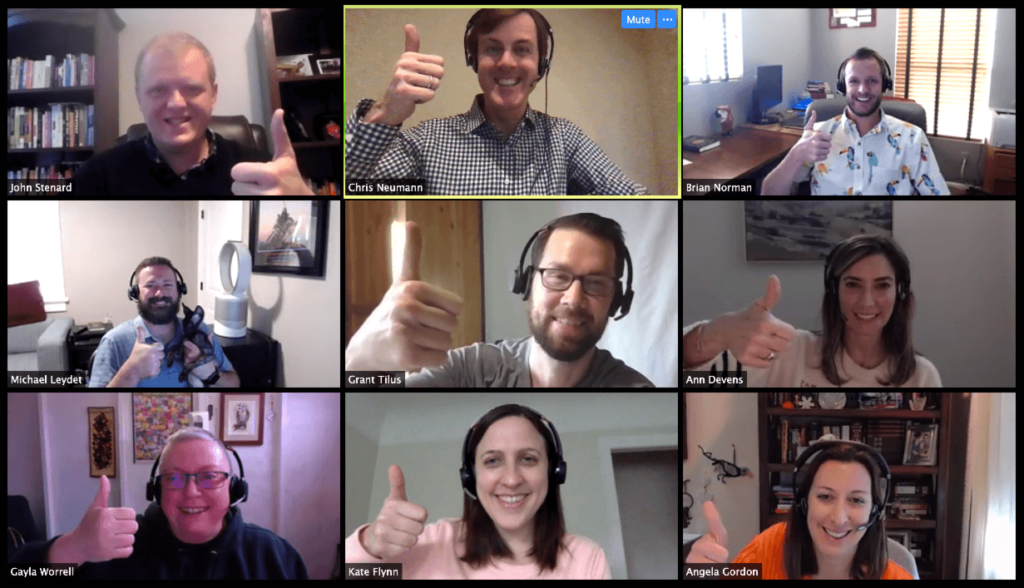Cro Metrics has operated as a fully-distributed team with employees throughout the U.S. since the company began. Over the years we’ve experimented with and optimized many aspects of remote work. With COVID-19 virus causing a rapid increase in the number of organizations working remotely, we’re sharing our best pro tips and practices.
Culture in a Remote Team (vs. Co-located)
- A large percentage of our communications take place via Slack. Slack or an equivalent group chat app is ideal for work comms and team building.
- We have a #water-cooler channel that is intended for chatting (just like at the real water cooler in an office).
- We also have a Donut-chat plugin that assigns people to meet 1:1 to get to know one another personally, since we don’t see each other in person very often (even if team members already know each other, this can be a useful space for building deeper connections).
- On Mondays, we ask what folks did over the weekend in the water cooler channel.
- Wednesdays are “Wellness Wednesdays” and we chat about what we’re doing to stay healthy.
- Fridays we have a “Get to know your remote co-worker” question where folks share interesting things about themselves.
- We have an #appreciation channel where people publicly acknowledge gestures of helpfulness by @mentioning colleagues.
- Some people love the focus they get from working at home, but others miss being in an office. Some of our team likes to work from a coworking space or coffee shop, but this might be less relevant with COVID-19 threat.
- It’s easy to not leave the house for days on end, but that is unhealthy. A simple 10 or 15-minute walk around the block between meetings is a simple way to de-stress and get out of the house.

Meetings and Meeting Etiquette
- Cro Metrics is a camera ON culture because it keeps people focused on the meeting (rather than multitasking) and also builds relationships more effectively than camera OFF. We recommend using your video conferencing system in full-screen mode as much as possible to avoid distractions such as responding to Slack or email messages during a call. Give participants your full attention.
- When running a meeting, the “grid” view is the best way to understand what is going on in the room since you’re able to see the subtle hand signals people use to indicate agreement, eg 👍. Snapping both fingers in view of the camera is a good way for a meeting participant to indicate agreement without interrupting the meeting.
- The sidebar chat is a good way to bring up a topic without interrupting the meeting. For more casual meetings or for the right cultures, it can be fun to use it to joke around with one another without detracting from the meeting itself.
- If you’re in a meeting with a group of people, keep your mic muted until you’re ready to talk. That way if your dog barks or you have other surrounding noises, it doesn’t startle the speaker or other attendees.
Setting up the Best Remote Workspace
- Nothing can be more frustrating than poor audio—especially if you’re in meetings a good part of the day. Equip the team with a comfortable headset with noise canceling on the microphone to minimize background noise. We’ve tried many and prefer the Plantronics Blackwire 725. We also like the Plantronics Voyager Focus (BT600) but it is Bluetooth and reliability is inconsistent—several team members have had intermittent issues that are disruptive.
- Zoom works the best of all the video conferencing platforms we’ve used. The free version is too limiting, but the paid tiers are affordable. (No, this is not an ad—you’re welcome, Zoom!)
- Lighting is key for video. Avoid being backlit—natural light, such as a window, should be behind your screen instead of in view of the camera.
- Home web routers often don’t perform well for videoconferencing. If possible, run a hardline ethernet cable to your computer. This may not be practical as a permanent solution, but ethernet cables on an easily retractable reel work well.
- Seating is important. Don’t just set up at the dining room table and plan to work there for weeks (fatigue will set in quickly). If the dining room is your ideal spot, invest in an ergonomic office chair. Better yet, opt for a sit/stand desk. Autonomous makes a good one for a reasonable price.
- Having a professional-looking background is important—especially if you’re client-facing. Opt for a plain wall and avoid having a bed or clutter in the background. A handy trick if you’re limited on options is to use a pop-up green screen you can use it during the day and store after work. Zoom also has a built-in feature to upload any image as your background.
- If you need to meet with clients or external folks, keep a “client shirt” just off-camera in your office. It’s easy to toss on the short prior to a meeting, even if you’re wearing shorts and slippers out of view!
- Position your camera so your head and shoulders are in full view and you aren’t cutting off the top of your head, chin or doing an extreme close-up. It only takes a minute to adjust your camera to an ideal position.

